Innovation of CFD Workflow Using Open Source

Utilizing open-source CFD isn’t simply about replacing commercial programs and reducing licensing costs. It’s about innovating CFD workflows by leveraging open source. This is a summary of the presentations at the 2025 OKUCC (OpenFOAM Korea Users’ Community Conference).
Questions about OpenFOAM or BARAM
Most of the questions about OpenFOAM or BARAM are as follows:
- Are the simulation results accurate?
- Is the simulation speed fast?
- Are the features sufficient?
- Is it stable?
- Do other people trust it’s result?
The answer to these questions is that they’re not much different from the dominant commercial codes in the market. Behind these questions, it seems, lies the distinction between high-end CFD codes and low-level CFD codes. This distinction, while deeply ingrained in many people’s perceptions, is in fact merely the result of a highly successful marketing strategy by a small number of commercial codes.
The above questions are all concern software performance. Using open-source software isn’t simply about software performance; it’s about workflow innovation. Other questions are necessary . Just as a country with only rifles considering the introduction of machine guns should prioritize the resulting tactical changes over the gun’s range and accuracy, it should also consider innovation in CFD workflows through open source.
Why Open Source – Changing the CFD Environment
With the advancement of CAD, CFD, and HPC technologies, the CFD environment is changing at a very rapid pace.
- In the past, a lot of computational time was a critical issue, but now a lot of computational conditions are becoming a critical issue.
- What was once a tool used by a small number of specialists has become a technology that can be utilized by many people in various fields.
- CFD analysis for research is becoming an integrated process in the design process.
- The need for multi-physics simulations that combine various physical phenomena beyond simple heat flow analysis is growing.
- HPC use has become widespread and cloud use is expanding.
- The combination of digital twins, artificial intelligence, multi-objective design optimization, and CFD is required.
In this changing environment, it seems that too many CFD workflows are still trapped in commercial code licenses and closed structures.
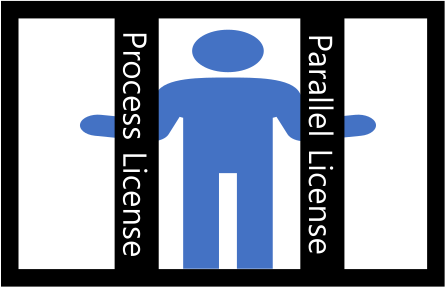
Workflow
Workflow limited to CFD refers to the CFD analysis process consisting of pre-processing, solving, and post-processing, but it can also be viewed from the perspective of linkage with the overall business system.
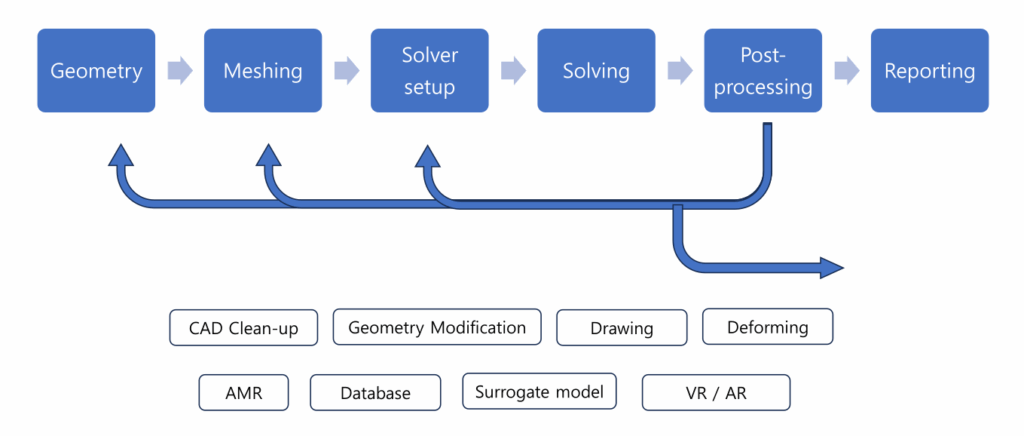
The CFD analysis process is widely perceived as a sequential, one-directional process: Geometry – Meshing – Solver setup – Solving – Post-processing – Reporting. However, in many cases, each step can branch out, creating many loops. Because of this, commercial codes also offer solutions under the name of workbenches. However, these solutions often only allow access to the company’s own products, or more precisely, to the solutions purchased. While open source allows for the implementation and automation of diverse workflows, the closed structure of commercial code inevitably limits workflow flexibility and automation.
This issue also arises when designing workflows that define how CFD operates within an overall business system.
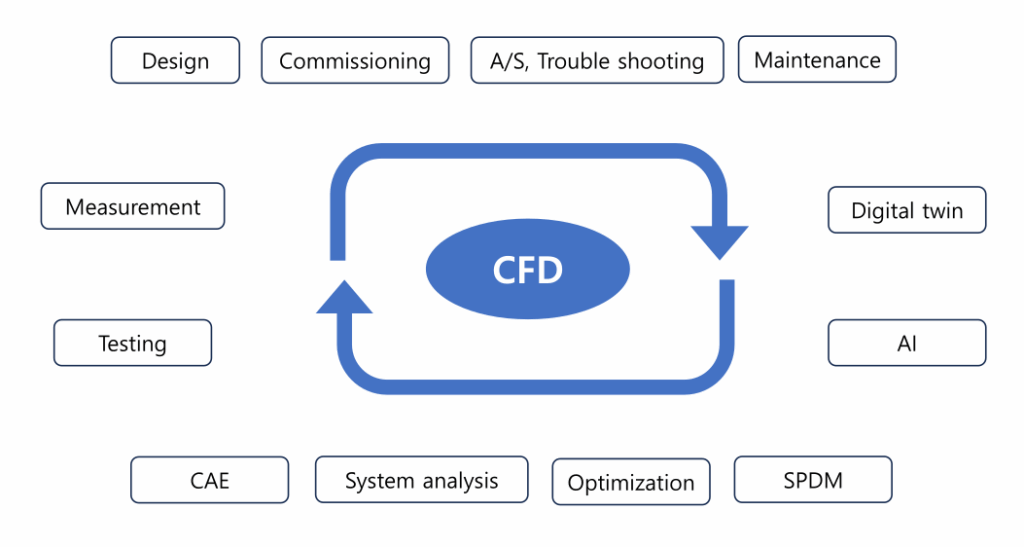
The current strategy of commercial codes is to unify all processes—CAD cleanup, meshing, CFD solvers, post-processors, CAE solutions, AI, digital twins, MDO, SPDM, system analysis, and more—with a single company. This is the way to maximize their value, and to achieve this, many engineering solution companies are consolidating into a smaller number of companies. While purchasing all solutions from a single company and designing the entire workflow is one option, I don’t consider this a viable approach.
The limitations of the existing workflow can be summarized as follows:
- High-cost commercial licenses, hidden algorithms, difficulties with automation, limited scalability, and challenges with collaboration and data management.
- Disjointed and manual workflow
- Workflow is determined by the limited number of license for users and cpu cores.
Workflows using open source have the following advantages:
- Automated pipelines, data management integration (SPDM), cloud/HPC scalability, and ML/AI integration.
- Automation of repetitive tasks, large-scale parametric studies, optimization, and real-time feedback
- It’s not just about replacing tools, it’s about revolutionizing the way we work.
Things to Consider When Designing a Workflow
There are many considerations when designing a workflow, but the following are considered crucial. If you primarily use commercial code, many of these considerations will be unnecessary, as some have pre-determined answers or no answer, no matter how hard you try.
- In which stage (field) will it be used?
- Who will use in each stage (field)?
- What is proper UX?
- What is your computing equipment operation strategy? – On-premise/Cloud
- How to integrate ML/AI or fuse test and analysis data?
- What are the digital twin integration plans?
- How to integrate with other solutions or systems?
- What software do I need and what license size is appropriate?
Who will do the CFD analysis – the analysis team vs. the design team?
Many organizations are forming so-called analysis teams specializing in CFD/CAE analysis. They receive work commissioned from design teams and other practical teams, perform calculations, analyze the results, and provide the results. This approach offers the advantage of efficiently achieving excellent results, as the analysis is performed by highly skilled experts. However, with a large number of external requests, there’s a risk that results may not be achieved within the desired timeframe, or that a relative lack of practical expertise may lead to inefficient calculations compared to the intended purpose. Furthermore, CFD engineers may become mere CFD modelers.
The best way is for the person who needs it to calculate it himself, but there are problems such as lack of expertise in CFD, licensing costs for commercial codes, and efficient operation of computational equipment.
There are two widely used approaches to this problem.
- Method 1 – Develop a dedicated program
- CFD experts establish the optimal analysis method through analysis verification.
- Design and deliver processes and UX to minimize human error and ensure a certain level of accuracy.
- Continuous feedback and improvement while using in the field
- Method 2 – Building a Surrogate Model
- Build simulation data for various conditions and build and deliver a surrogate model.
- Using methods such as Kriging, Reduced Order Model, and Machine Learning
- Continuous model updates
Both methods require the use of open source.
Examples of Workflow Innovation
Development of dedicated programs
Dedicated program development is being developed not only for the purpose of handing over tasks to the design team, but also to improve the work efficiency of the analysis team.
The development of a dedicated program involves steps such as validating the target problem, determining optimal analysis conditions, establishing an automation strategy, and creating a user experience (UX). Case studies developed by NEXTFOAM include air conditioner outdoor units, hazardous material diffusion, data center cooling, ship resistance analysis and ESD(Energy Saving Device) design, automotive HVAC, heat exchangers, tunnel fires, dispensing, MLCCs, slot die coating, and platform screen doors (PSDs).
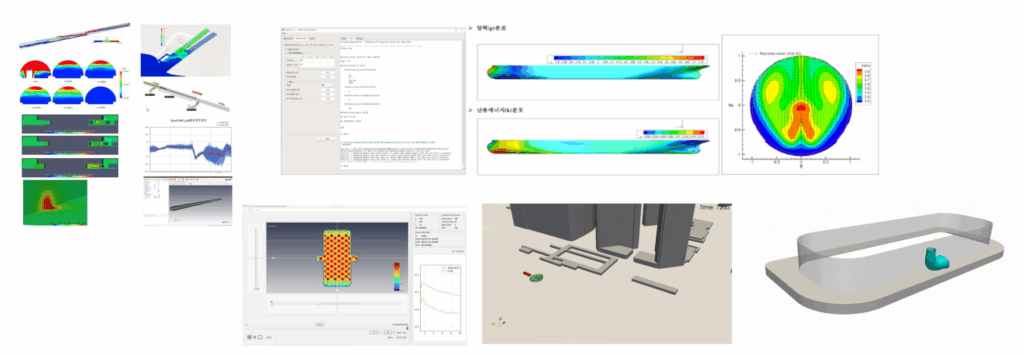
Integrated automated interface for aircraft CFD analysis and design
We developed a technology that automates the entire aerodynamic analysis process, a key component of aircraft development, and integrated it with a design framework to create an integrated interface. To automate the analysis process, we developed modules for automatic aircraft shape generation using parameters, automatic surface and volume mesh generation, solver setup for calculations, and automated post-processing. Missile DATCOM was used for shape parameters, OpenCascade for shape generation, and Salome for mesh generation. ParaView macros are used to automatically generate flow field distributions and surface images, and an aerodynamic database is generated in SQL and CSV file formats for integration with the design framework. The integrated GUI provides functions such as parameter input, job monitoring, and 3D/2D image viewers, and each module can be run in Python via the integrated CLI.
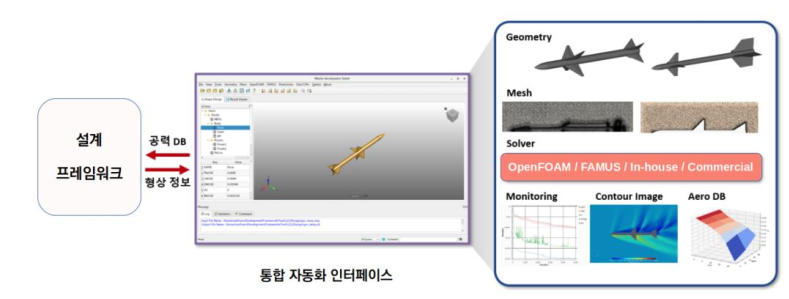
Aircraft aerodynamic DB construction framework
To build a CFD-based aerodynamic database, we developed an automated framework and GUI program based on surrogate models. The surrogate model technique significantly reduces the cost and time required for database construction by modeling the response of actual models at a relatively low cost. It also enables aerodynamic characteristics to be derived for all continuous combinations of conditions beyond the experimental points. Surrogate model construction requires multiple layers of work, including design-of-experiment (DOE)-based analysis point selection, flow analysis, surrogate model generation, and validation. By integrating these disparate tasks into a single framework, we achieve efficiency and scalability. Appropriate analysis points are derived for variables such as the aircraft’s Mach number, AOA, bank angle, and fin deflection angle, and a kriging model is generated to build the aerodynamic database. See details .
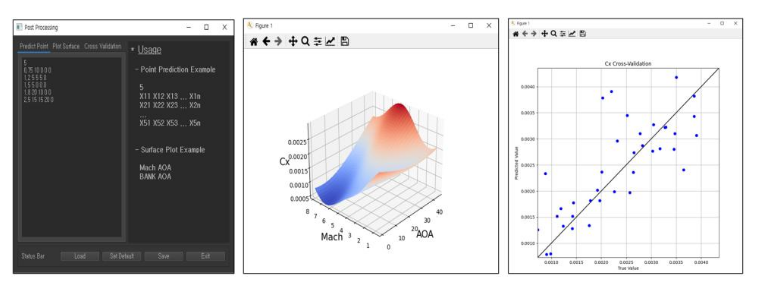
Multi-objective design optimization framework
We developed a front-end shape optimization design framework to optimize the aerodynamic performance of next-generation high-speed trains. Using Bézier curves and surfaces, we derived a shape model and 27 shape parameters that can simulate the front end of a high-speed train. Surrogate models were generated by analyzing 500 sample cases, and single-objective and multi-objective optimizations were performed for multiple objective functions, including drag, micro-pressure waves, and overturning moments from side force, using the NSGA-II technique. We confirmed that overall performance improvements of 5-20% were possible for all objective functions. We implemented a framework that derives the optimal shape by manipulating objective function weights. See details

Digital Twin Integration of Contaminant Diffusion
To predict air pollution spread, we implemented a CFD analysis environment as a SaaS service on the Korea Land and Geospatial Informatix Corporation’s digital twin platform, maximizing usability and accessibility. We also integrated sensor measurement data with simulation data. CAD data for the target area’s terrain, buildings, and nearby structures is automatically generated. Meteorological information is linked to reflect actual weather data in the simulation, and automatic mesh generation and simulation execution enable simulations without specialized knowledge, creating a SaaS solution. See details

Analysis automation and web platform using 3D CAD meta data
Automating exhaust gas flow analysis for marine engines involves modeling the geometry of the piping system. Because 3D CAD cleanup of the piping system is a arduous task, we use Salome scripts to automatically generate the geometry and mesh of the flow area, without using CAD geometry. We implemented a user experience (UX) on web platform to enable direct use by multiple designers.

Drone analysis using Excel sheet
We developed an automated module for mesh generation and fluid dynamics analysis using CAD files generated from a parameter-based geometry automation framework for unmanned vehicles. A post-processing module is included that automatically extracts pressure fields, forces acting on each module, and aerodynamic coefficients from the calculation results. The geometry files consist of a propeller, boom, fuselage, spinner, motor, canard, and wing, and the surface mesh size and feature edge extraction options are automatically set for each component. Analysis conditions are input from an Excel sheet, including flight conditions (speed, angle of attack, side slip angle), rotor characteristics for actuator disk application (Cp, Ct, lift direction), and calculation conditions. The entire process—mesh generation, fluid dynamics, and post-processing—is executed with a single Python script.

NEXTFOAM’s case
NEXTFOAM is a CFD consulting company that uses open source programs such as BARAM, OpenFOAM, OpenCascade, Salome, ParaView, VTK, FreeCAD, OpenScad, Pyside, and Python . We manage improvements to our own BARAM and OpenFOAM codes using Github and Gitlab.
The licensing costs that NEXTFOAM has saved over the past 15 years by using open source amount to over 30 million dolor, assuming that 15 people each use an unlimited user license with 3 cores.

CFD Code
The CFD code is based on OpenFOAM, improving performance and developing necessary features.
The developed code is integrated and managed as a fork of OpenFOAM called NextFOAM, which integrates with OpenCFD code to enable access to the latest OpenCFD features.
Geometry
- Automated shape creation based on OpenCascade
- Development of a dedicated CAD program
- Development of a program for automatically generating terrain and architectural shapes using digital topographic maps.
- Creating shapes using Bezier surfaces
- CAD Cleanup using commercial code (ANSA)
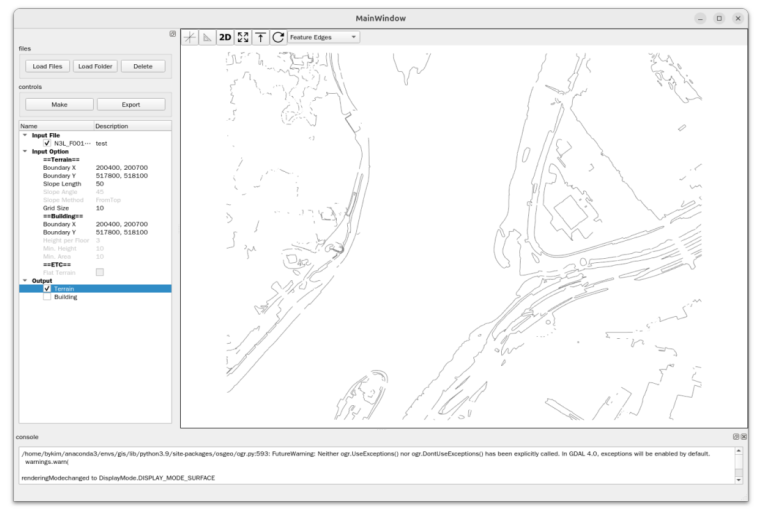
Mesh
- Development of baramMesh using snappyHexMesh and various utilities
- Development of a program to generate tetrahedral mesh using Salome and convert to polyhedral mesh.
- Development of a mesh deforming utility (deformMesh)
- Development of STEP file input and boundary separation functions for snappyHexMesh
- Commercial code mesh conversion
- Development of a StarCCM+ mesh conversion program using Python
- Development of an automatic conversion program to multi-region mesh from Fluent mesh.
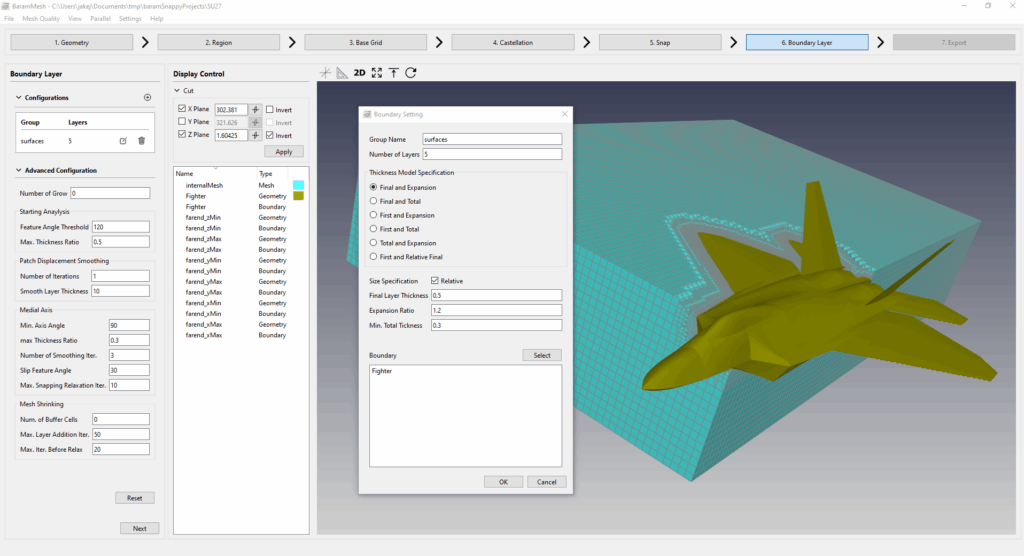
Solver Setup
- baramFlow UX development
- Automatic generation of baramFlow cases using LLM
Post-processing
- Development of baramFlow post-processing functions
- Developing automated processes using ParaView
- Development of automatic report generation function
- Development of VR/AR integration functions
AI, Data based simulation
- baramFlow’s batch run function
- Development of a real-time simulator using POD/ROM – integrated into baramFlow
- Developing a surrogate model using ML
- Development of a simulation technique using PINN
- Linking with measurement data using Gappy POD
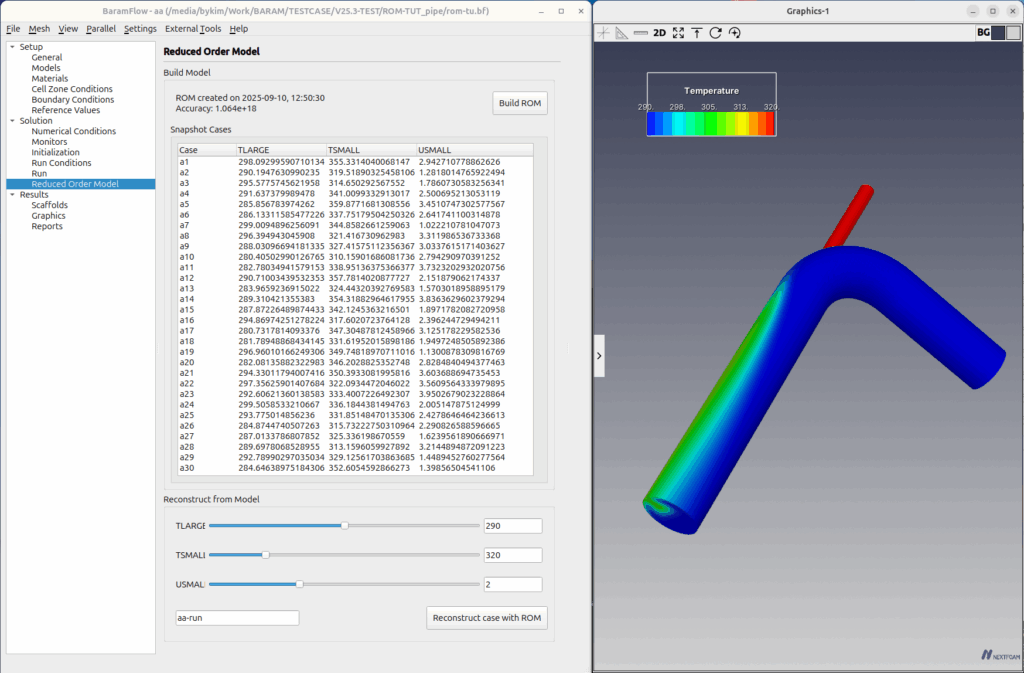
The expansion of open source CFD, BARAM
The use of open-source CFD is rapidly expanding. The Baram Portal (baramcfd.org), operated by NEXTFOAM, had 9,700 active users and 260,000 events from January to August 2025. Active users reside in 117 countries, with Korea accounting for approximately 30%. The download count is 988 times, and 534 people have downloaded it.
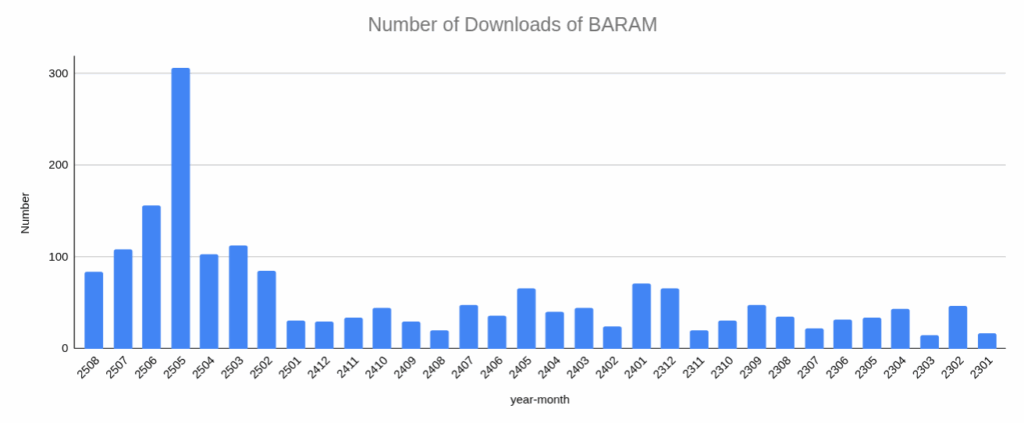

Future Outlook and Conclusion
In the future, CFD will go beyond simple simulation and connect with digital twins. By integrating real-time sensor data with CFD models, it will be possible to predict the state of operating systems. Combined with machine learning, surrogate models will be created, enabling CFD-level predictions in seconds. All of this will evolve alongside the open-source ecosystem, driving innovation together across businesses, academia, and the community.
Open source isn’t simply a free alternative; it’s a tool that revolutionizes the CFD workflow itself. Transparency, scalability, and automation are its core values, leading to faster design cycles, lower costs, and greater innovation.
We welcome your participation in the development of open source CFD programs.
Things to consider when adopting open source
Many people try to get OpenFOAM or BARAM training and then conduct a proof-of-concept (POC) himself, but this doesn’t seem like a good approach. OpenFOAM isn’t easy. There’s no need to use OpenFOAM. Even with BARAM, things won’t be as fast as you might think. It’ll likely take about the same amount of time and effort as initially implementing commercial code. As time goes by, other things can arise, and things can easily fall through the cracks. It’s best to work with an expert rather than trying to do it alone.
Many people are reluctant to adopt open source. Processes already established with commercial software are extremely powerful. Improving existing processes is often hindered by various non-technical factors. Sometimes, they struggle to find something that doesn’t work.
Don’t be too fixated on “free.” Innovation is what matters, not free.